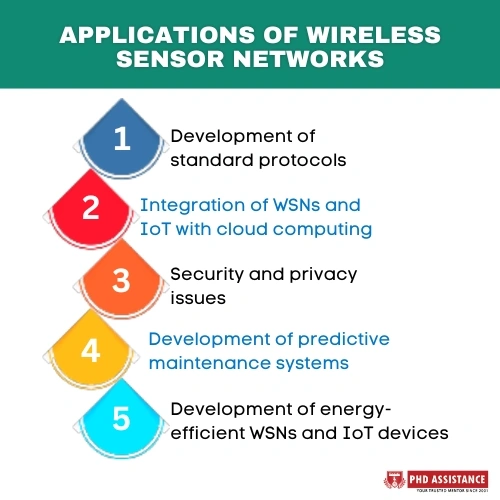What are the future recommendations discussed in the following paper, “Applications of Wireless Sensor Networks
Rapid developments in technology, industry, and social trends in the twenty-first century have resulted in the fourth industrial revolution (IR 4.0). IoT and WSN are utilized in a variety of control systems, including environmental monitoring, home automation, and the detection of chemical/biological attacks. This comprehensive literature review evaluation provides a wealth of information about Industry 4.0, identifies research gaps, and suggests future initiatives. IoT devices and software are used to analyze and transfer data gathered from WSN devices to remote sites.
Introduction
The paper “Applications of Wireless Sensor Networks and Internet of Things Frameworks in the Industry Revolution 4.0: A Systematic Literature Review” identifies several future research recommendations for the application of wireless sensor networks (WSNs) and Internet of Things (IoT) frameworks in Industry 4.0. These recommendations include:
-
- Development of standard protocols: Future research should focus on developing standard protocols for communication between IoT devices and WSNs. These protocols should be compatible with different types of devices and enable seamless integration of different systems.
- Integration of WSNs and IoT with cloud computing: The integration of WSNs and IoT with cloud computing can enable the storage and processing of large amounts of data generated by these systems. Future research should focus on developing cloud-based frameworks that can handle the large-scale data generated by WSNs and IoT.

- Security and privacy issues: The use of WSNs and IoT in Industry 4.0 raises essential security and privacy concerns. Future research should focus on developing secure and privacy-preserving WSN and IoT frameworks that can protect sensitive data and prevent unauthorized access.
- Development of predictive maintenance systems: WSNs and IoT can enable predictive maintenance of industrial equipment by monitoring and analyzing data from these devices. Future research should focus on developing predictive maintenance systems that can accurately predict equipment failures and prevent downtime.
- Development of energy-efficient WSNs and IoT devices: The energy consumption of WSNs and IoT devices is a significant challenge in Industry 4.0. Future research should focus on developing energy-efficient WSNs and IoT devices that can operate for long periods of time without requiring frequent battery replacements.
Overall, the paper highlights the potential of WSNs and IoT in Industry 4.0 and provides important recommendations for future research in this area.
Conclusions
This systematic literature research examined risks related to Wireless Sensor Networks (WSN) and the Internet of Things (IoT) networks. It was discovered that these networks are the primary attack surfaces used by attackers to generate meaningful patterns from system and user data. WSN and IoT have progressed quickly to suit the growing need for traditional application scenarios like plant automation and remote process control systems. These smart devices are also utilized to increase the efficiency of current networks and open new avenues for automating and safeguarding industrial operations.
About PhD Assistance
At Ph.D. Assistance we assist in developing an exhaustive literature review comprising various academic sources, including journals, textbooks, and newspaper articles, to develop a research framework / conceptual framework, hypothesis, and questionnaire with appropriate sources favouring dissertation title. The services related to dissertation literature review rendered by the experts of PhD. Assistance ends up in shaping up your research work to be ready for journal publication.
References
Majid, M.; Habib, S.; Javed, A.R.; Rizwan, M.; Srivastava, G.; Gadekallu, T.R.; Lin, J.C.-W. Applications of Wireless Sensor Networks and Internet of Things Frameworks in the Industry Revolution 4.0: A Systematic Literature Review. Sensors 2022, 22, 2087.



